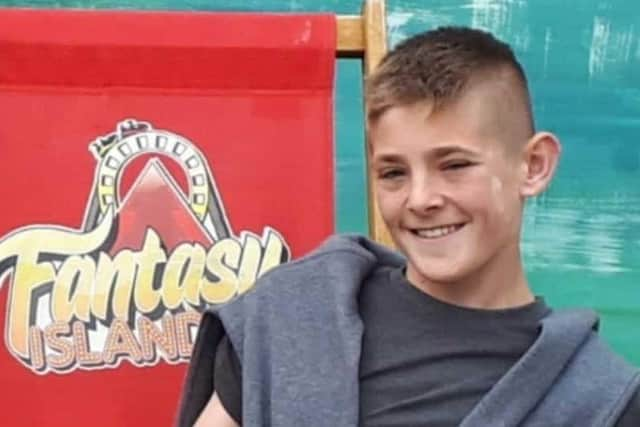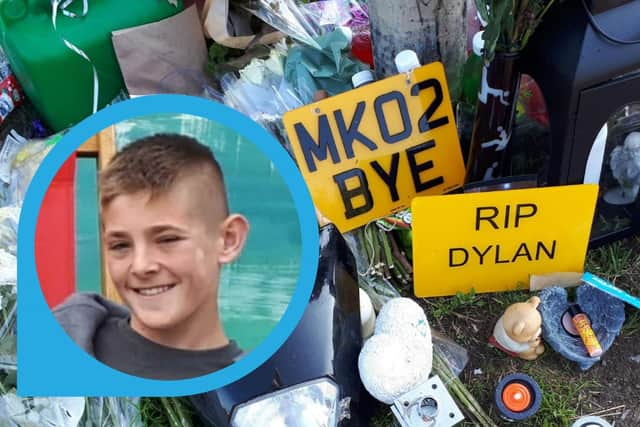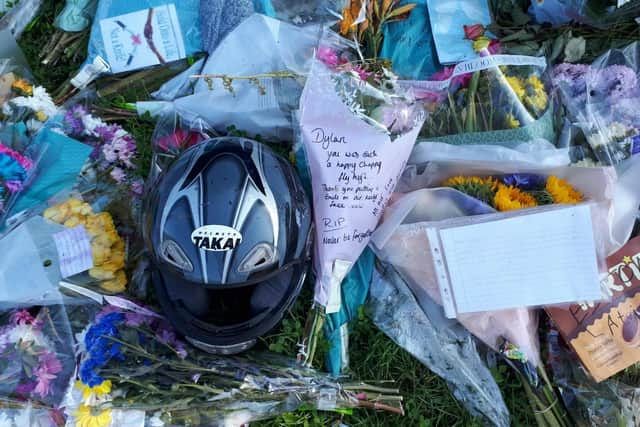Report into life and killing of Wellingborough teenager Dylan Holliday reveals missed opportunities to share information
and live on Freeview channel 276
A report into the life – and death – of a Wellingborough teenager has been published revealing official shortcomings in attempts to help him.
Dylan Holliday was killed in a town underpass in 2021, stabbed by another teenager now serving a 12-year sentence for manslaughter.
Advertisement
Hide AdAdvertisement
Hide AdHis case, and that of five other teenagers who had been exposed to or suffered youth violence – including another Northamptonshire teenager in local authority care who was convicted of murder in Milton Keynes – have featured in two reports by an independent reviewer.


Northamptonshire Safeguarding Children Partnership (NSCP) ordered a Child Safeguarding Practice Review (CSPR) in September 2021, following advice from the National Child Safeguarding Practice Review Panel.
This paper has confirmed that ‘Young Person BG’ referred to throughout one of the reports is Dylan Holliday – we have chosen to use his name.
Professionals who had worked directly with Dylan met to pool their knowledge. Those who worked with him described Dylan as a ‘livewire’, ‘polite and respectful’.
Advertisement
Hide AdAdvertisement
Hide AdOne said: “Dylan was a lovely person…he would always shout my name, come over and have a chat in the street, even when I had finished working with him. Dylan didn’t want to lose sight of who he was – even if he was in in the community with friends, he would still stop and say hello.”


Another said: “When Dylan was upset, sometimes I just wanted to give him a hug and tell him it would be ok.”
The authorities working with the family knew Dylan had witnessed domestic violence while still at primary school. He used cannabis from the age of 11 and his school attendance began to slip. By the time he was 12 he had been permanently excluded. It took two years to get an Education Heath Care Plan in place and returned to education in 2019. At this time Dylan broke his leg so badly in a bicycle accident medics feared he may need his leg amputating after complications set in.
Described by professionals as having been a ‘vibrant, sociable young person’, Dylan was well-known on his estate but his ‘willingness to socialise outside of the family home’ led him into the hands of older people.
Advertisement
Hide AdAdvertisement
Hide AdHanging around with youths, some members of drugs gangs, Dylan was made subject to a Child Protection Plan in 2018-19 – the same year as his Attention Deficit Hyperactivity Disorder (ADHD) was diagnosed – and his family was relocated due to anti-social behaviour concerns and exploitation risks. He received support from the Youth Offending Service after being involved in anti-social behaviour offences and substance misuse. The Child Protection Plan finished in November 2019, after his education attendance had improved and concerns over his being exploited had reduced.


But Dylan’s life spiralled out of control.
By the end of January 2020 his ‘Child In Need’ plan was closed. A month later he confessed to a teacher he had been found out-of-county the previous evening in a vehicle with adults after being chased by police.
As the Covid pandemic disrupted any education he was receiving, ‘fluctuations’ were noted between his ADHD medication and him using cannabis – choosing to self-medicate with illegal drugs.
In May 2020, Dylan left home to live with a family friend but suffered ‘financial exploitation’ and was again found in a car with adults by police. That September, Dylan showed a teacher a video of himself stealing a moped.
Advertisement
Hide AdAdvertisement
Hide AdIn the 10 months in the run-up to Dylan’s killing, various agencies including social workers, police officers, educators, specialist medical teams and child protection experts had dealings with his family.
A Child Protection Conference was triggered after Dylan was found to have been given a sleeping tablet meant for his mother. Another Child In Need Plan ran from November 2020 until February 2021 but Children’s Services ceased involvement with the family as it ‘had not been possible to see Dylan’, and he and his mum did not want Children’s Services’ involvement.
Incidents involving the police increased with domestic incidents and on one occasion threatening another young person with an ‘implement’.
As Dylan prepared for college, he was helped by a specialist ASD/ADHD team to resume medication as he waited for the new term he spent his time riding around the Queensway estate on a moped – without a license plate while not wearing a helmet.
Advertisement
Hide AdAdvertisement
Hide AdIn July 2021, he suffered serious injuries after being involved in a motorcycle accident.
Tragically, on August, 5, 2021, Dylan was stabbed to death in an underpass where he had been ‘chilling’ and smoking cannabis with a friend. He was 16-and-a-half-years-old.
Opportunities missed
The Child Safeguarding Practice Review discovered ‘numerous instances’ of ‘limited multi-agency communication’ that meant risks to Dylan were not shared, with key information not being flagged up.
The report said: “MASH (Multi Agency Safeguarding Hub) risk assessments were often concluded with limited understanding of family history and aggregated Child Criminal Exploitation (CCE) risks for Dylan that had accumulated over time.
Advertisement
Hide AdAdvertisement
Hide Ad"Opportunities were missed to share information within the MASH to gather intelligence and understand potential extra-familial harm risks, such as police not sending in Child Public Protection Notices (PPN’s) to MASH, or assumptions made that other agencies were aware of concerns for Dylan."
Northamptonshire Police have since changed their processes to ensure that a Child PPN is sent to MASH as a result of all contacts with children under 18 containing a potential safeguarding risk.
Ivan Balhatchet, Deputy Chief Constable of Northamptonshire Police, said: “These are two important reports which seek to bring learning to agencies following the tragic deaths of two teenagers who were fatally stabbed.
“In the first, we have worked with partners in both Northamptonshire and Milton Keynes to explore the lives of the victim and their killer, both of whom were exposed to neglect, violence and parental substance abuse from an early age.
Advertisement
Hide AdAdvertisement
Hide Ad“The report draws out the importance of communications between agencies, including the police, when a child in care, one at risk of gang involvement, is placed in a new local authority area, a factor which the CSPR notes was ‘inherently complex’.
“The report notes good partnership working in the cases of both children and acknowledges key learning around information-sharing between police forces when children have been moved to be a different area to keep them safe from gangs.
“This CSPR sets out the enormous challenges agencies face in tackling gang involvement and child criminal exploitation.
“The report into Young Person BG (Dylan) also draws out really important learning. This was a child who faced some very significant challenges throughout their short life - low-level criminality, risk of child criminal exploitation, neurodiversity issues and significant cannabis use, all against a background of Covid which impacted the support given to try to safeguard them.
Advertisement
Hide AdAdvertisement
Hide Ad“Since the events of August 2021, the police and partners have embarked on a project to introduce a co-located multi-agency Child Exploitation Hub which seeks to identify children at risk of Child Criminal Exploitation not just Child Sexual Exploitation which had been the case in the past. The report notes the importance of information sharing across all agencies in cases where gang activity is ongoing, and this new team will ensure fast and effective sharing of information in cases such as this one.
“As part of our wider prevention strategy the force is now deploying data analysis software which aims to identify young people at risk of exploitation, and we continue to work alongside the Community Safety Partnerships to build problem profiles which allow all agencies to monitor children at risk.
“We note all the recommendations made in the report and will continue to work alongside our partners to explore further opportunities to safeguard young people in this county.”
The report’s conclusion
The report’s conclusion dealing with the Wellingborough teenage does not conclude ‘definitively’ that Dylan’s death would have been avoided.
Advertisement
Hide AdAdvertisement
Hide AdBut it does highlight the need for professionals to take into account factors including family history, risks from outside the family, what had been done to help and taking into account medical issues like ADHD and for professionals to challenge cannabis use to identify risks associated with the drug whether dealing or consuming.
It said: “Whilst it is not possible to say definitively that Dylan’s death would have been avoided through enhanced identification, threshold decision-making, assessment and intervention around extra familial harm, this CSPR has clearly highlighted the importance of work with young people being fully informed by a professionally curious approach to family history, previous risks and interventions around extra-familial harm, working knowledge of the real-terms impact of ADHD for each individual young person, ongoing professional challenge of cannabis use to identify potential extra-familial risk and effective risk analysis of intra versus extra-familial harm risks.”
Julian Wooster, chairman of Northamptonshire Children’s Trust, the county’s social care services that provides support to children in need of help and protection, said: “Alongside our partners, we have developed a multi-agency strategy which includes a training programme with the aim of ensuring all professionals understand the level of risk a young person is at so that they receive the correct support at the right time.
“We continue to work alongside our partners in the councils, police and health to recognise and address risk factors contributing to children and young people carrying knives and will do everything we can to tackle issues leading to serious incidents such as these.
Advertisement
Hide AdAdvertisement
Hide Ad“Keeping children and young people safe is at the heart of all we do, and we have already made several changes including ensuring that any professionals unable to attend meetings where there are concerns about children and young people now need to provide a report to ensure we have a full picture of their life.”
Yvonne Higgins, chief nursing officer, Northamptonshire Integrated Care Board extended her thoughts to the families of the two boys who died.
She said: “These are two extremely sad cases where young people have needlessly lost their lives. Knife crime has caused far too many deaths and serious injuries in our county.
"We welcome the publication of these learning reviews by the Safeguarding Children Partnership (of which we are a statutory partner) and the opportunity to understand the associated risk factors more fully for young people either becoming victims of or committing knife crime.“The NHS in Northamptonshire is absolutely committed to playing our part in trying to reduce knife crime in our community and we will continue to work with agencies to recognise and address the additional risk factors and to share information with agencies where this is required. This will include building a better understanding of the extrafamilial harm risks to young people in our communities and the pressure faced by young people that lead them to carry knives.”
Advertisement
Hide AdAdvertisement
Hide AdCllr Scott Edwards, North Northamptonshire Council’s executive member for children, families, education and skills, said: “We welcome the reviews - they have been painstakingly researched and present a detailed analysis of the circumstances surrounding both incidents. We wholeheartedly accept the recommendations which have been laid out.
“What they both demonstrate is the need for all partners in North Northamptonshire and the county as a whole, to work together to create the sort of safe communities where young people can thrive.
“We recognise that knife crime is a blight on our communities and although a great deal has been done and is ongoing to make our streets safer, we accept that we must go further in tackling this concern.
“We need to further recognise when young people might become vulnerable to becoming gang members or be lured into criminality.
Advertisement
Hide AdAdvertisement
Hide Ad“We also need to understand why our young people are carrying knives and earn their trust to show that we are here to help. Working with our partners and the voluntary sector is key to this and great strides have already been taken to connect with communities.
“We also acknowledge that we need to work to increase what is on offer for young people in North Northamptonshire.
“So far, key projects in partnership have seen the improvement of existing youth facilities to develop more sports opportunities to encourage young people to be more active and take up volunteering, training and learn employability skills. We’re also working in partnership with the community on the ongoing re-development of a bike track in Wellingborough.
“Our Safer Streets initiatives have also reached out into neighbourhoods to improve lighting, install more CCTV and introduce knife amnesty bins.
Advertisement
Hide AdAdvertisement
Hide Ad“There is no easy fix here, however we have a resolute commitment in making our communities better for all our residents, and particularly our young people, who are the future of North Northamptonshire.”